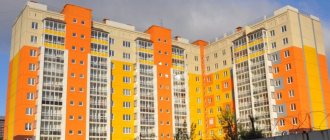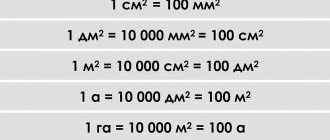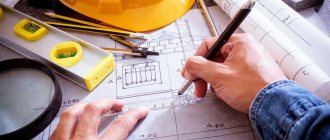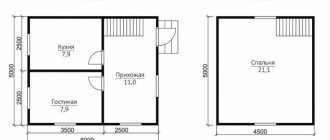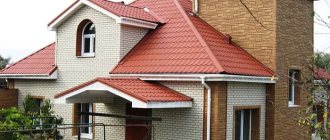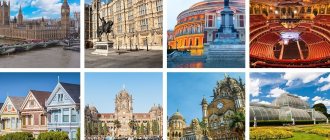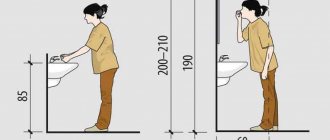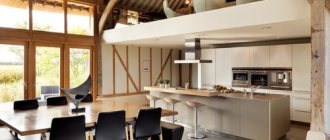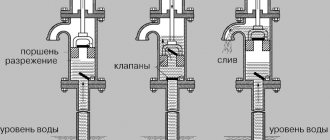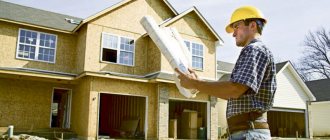The height of a 16-story building in meters is a figure that many people not related to construction calculate easily and simply, as is the case with five-story buildings. Multiplying the estimated height of a floor of three meters by the number of floors, such people easily imagine that a five-story building must certainly be 15 m. Consequently, it turns out that a nine-story building is 27 m, and a house of 16 floors, naturally, will be 48 m, but such the calculations are incorrect.
Construction of a sixteen-story building
Multi-storey single-entrance residential building with a public part of 16 floors
Arina Levina
November 11, 2021
- 0
350
Course project. Contains RPZ, 3d model and drawings: plans of the 1st and typical floors, section 1-1, facades, general plan, visualization, floor roof. Includes a 3D model of the general perspective of a multi-story residential building. Project of one entrance multi-storey residential building with a public part. The building has a stepped plan. One-section house,
Architectural drawings. Multi-storey houses and buildings / ArhiCAD
Moscow start
For Muscovites, the renovation program, designed for 15 years, came as a bit of a shock, and after its adoption on August 1, 2021, controversy and indignation in the press, social networks and district forums do not stop. After all, the program will affect more than a million residents from more than 5,000 homes. The first wave of indignation was rather a common reaction to the fact that a new phenomenon was coming into our lives - large-scale, incomprehensible, inevitable. But this wave soon subsided, largely thanks to a wide advertising campaign and explanatory work, for which the mayor's office allocated considerable resources. More than 83 percent of citizens whose housing was included in the renovation program are ready to move to new homes. This was stated in October last year by the deputy head of the capital's urban planning policy department, Andrei Valuy, noting that Muscovites are going to actively use the so-called additional purchase.
Photo: Natalya Seliverstova / RIA Novosti
Indeed, when the initial negative reaction subsided, many families took a fresh look at the upcoming ordeal, seeing positive aspects in the move. First of all, the opportunity to get housing of a larger area or with a greater number of rooms by paying the difference with a 10 percent discount. However, the joy was short-lived. The first settlers were still sharing positive reviews about the new apartments and new houses, but a second wave of discontent and criticism had already begun to spread across Moscow, which was already difficult to explain by rejection of something new.
Multi-apartment residential building 16 floors with built-in retail premises
Puella Novis
February 5, 2021
- 0
1 918
Monolithic residential building in a modern style. This thesis paper presents 4 sections: feasibility study of the project, construction technology, construction organization, life safety. Architecture. Floor plans and elevations. Technological map for the installation of standard monolithic walls and ceilings
Project drawings / Architectural drawings. Multi-storey houses and buildings
History [edit | edit code]
Serial design of housing originates from standard projects that have historically developed in different countries and among different peoples, which optimally took into account the traditions and way of life, weather conditions, the availability of building materials, the well-being of families, etc. For example, the traditional Russian log hut, which appeared in IX-X centuries in the course of slow evolution over the centuries and to this day, it has been divided into several typical options: a four-walled hut
the poorest peasants, a common
five-walled hut
for middle-income families,
a cross-shaped hut
, which was built by wealthy residents, could accommodate a large family or a whole clan of several families, less common were
the purse house
and
the six-walled hut
. In the southern regions with a milder climate, where there was not an abundance of construction timber, mud huts were built on a frame base, and among nomadic peoples, easily dismountable tent-type yurts were widely used [3].
16-storey residential building with built-in retail premises
yfnfkbithtvtnjdf
December 16, 2020
- 0
2 856
Diploma project on the topic “16-storey residential building with built-in retail premises.” The configuration of the building is complex in plan with maximum dimensions of 32.33x14.67 m. The height of the 1st floor is 3.3 m. The height of residential apartments from the 2nd to the 16th floor is 2.8 m. List of drawings of the diploma project Plan of the 1st floor, explication of the premises , list of door openings. Plan 2-16
Architectural drawings. Multi-storey houses and buildings / Construction, reinforced concrete structures, metal structures
Construction of a 12-apartment residential building
The residential building consists of 2 identical blocks. Each block has 6 symmetrically located apartments - 2 one-room (studios), 2 two-room and 2 three-room (two-level). Information on the construction of a 12-apartment residential building in Varna, Bulgaria Location The plot is located in the north-eastern part of the resort city of Varna, which is the second largest and one of the most prestigious cities in Bulgaria, with developed infrastructure and a population of 350 thousand. residents. The Sotira district, in which the site is located, is an environmentally friendly green zone of the city, at an altitude of 190 m above sea level. It is located on the slope of a low mountain and is protected from the prevailing northwest winds, but is open to the sea with a light summer breeze, and is maximally landscaped, which creates its own unique and favorable microclimate. To a public transport stop - 700 m. To the city beach - 5 km along the road (7 minutes by car or 30 minutes on foot). The area is provided with all necessary communications for a comfortable stay. Design solutions The residential building consists of 2 identical blocks. Each block has 6 symmetrically located apartments - 2 one-room (studios), 2 two-room and 2 three-room (two-level). All 1-2 room apartments have separate entrances, 3 room apartments are located in pairs. The layout of the apartments is designed with the absence of “extra” areas (corridors, terraces, etc.). From the 2nd and 3rd floors there will be a beautiful view of the central part of the city and the sea. On part of the flat roof of 3-room apartments there is a terrace of 20 m2, which is not included in the total area of the apartment and on which it is possible to arrange an individual recreation area with a barbecue. All one-room apartments have an open terrace, each with an area of 6.5 m2, which is also not included in the total area of the apartment. All 2-room apartments have balconies, each with an area of 4.7 m2, for complete outdoor recreation. Taking into account the predominant number of sunny days per year (according to statistics, up to 300 days), as well as to save electricity, at the request of developers, apartments can be equipped with solar panels (according to preliminary calculations, the investment will pay for itself within a year, with permanent residence). The entrance to the local area will be equipped with automatic gates and isolated from strangers. The lower area of the yard, as a common recreation area, will be landscaped and equipped. At the request of most residents, it is possible to place a swimming pool, gazebo with barbecue, etc. There are 12 parking spaces for cars in the local area. Conditions and terms of construction The design solution allows, if necessary, construction to be carried out in 2 stages, one block at a time. Currently, a working draft has been developed and agreed upon in full. A building permit, opening a site, and other documents for starting construction work can be obtained within 2-3 weeks, during the period of registration of the purchase of a land plot, preparation of contractual and financial documents with the investor. During the period of construction work, the site is provided with water and electricity, and a temporary utility room has been installed. The construction will be carried out by the general contracting construction and architectural EOOD, which has the right to carry out this type of activity, as well as all the documents required by Bulgarian laws, and is registered with the “Inscription Agency” under No. 20120306135406 dated 03/06/2012, in Sofia. The company guarantees high quality construction and installation work, with mandatory photo recording of the main stages of construction and certain types of work. The required amount of investment in construction is 513 thousand euros (38.5 million rubles, at the exchange rate - 75 rubles 1 euro, see summary of construction costs). Investments in construction will be carried out in stages (in tranches), throughout the entire construction period, as necessary (see financing schedule). The construction of houses with full amenities is planned to be completed within 12 months. To save money invested by the investor, construction can be carried out in 2 stages, one block at a time (after the sale of apartments at the stage of constructing the frame of the first block, the funds received are used for further construction). With this option, the amount of investment will be significantly reduced and will amount to 231 thousand euros (17.3 million rubles, at an exchange rate of 75 rubles 1 euro). At the same time, the construction period can be 18 months. Parking spaces are registered separately for apartment owners at a price of 1.5-2.0 thousand euros per parking space, depending on the location. In practice, houses in Bulgaria are rented to the extent of the Bulgarian national standard “BDS”* (analogous to the Russian construction version), with registration of “Act No. 15”***, which allows you to legally register the property before its full acceptance into operation. This proposal assumes exactly this option, in which the cost of apartments is set at 690 euros 1 m2 (average price in the area). The investor's income will be 223 thousand euros (43.5% of the invested funds, see calculation of investment efficiency*****). To increase the selling price and increase the investor's income, the turnkey construction option is possible, which is currently in high demand and guarantees a quick sale. According to realtor forecasts, given the lack of offers for the sale of this type of real estate in the area, as well as the favorable location, the architecture of the house and the compact layout of the apartments, the price, with this option, could “rise” to 900 euros per 1 m2. With additional investments (52 thousand euros - on average, 50 euros per 1 m2), the investor's income can amount to 389 thousand euros (68.8.0% of the invested funds). Legal registration of real estate, according to Bulgarian laws, can be carried out after registration of “Act No. 15”**, until the house is fully put into operation (“Act No. 16”***). However, if the purchase and sale of apartments, according to an agreement between the seller and the buyer, was carried out at the construction stage, the buyer will have the right to reduce its cost, as well as to adjust the layout of the apartment and replace finishing materials, within the limits of the prices included in the project. At current sales prices of 1 m2, construction organizers have a real opportunity to carry out such actions, which, in turn, will significantly increase the demand for the proposed real estate. *BDS is the Bulgarian national standard (an improved analogue of the Russian “build version”). The condition in which the property is transferred to the customer. The common parts of the building are completely ready. In the apartments, the walls and ceilings are finished, entrance and interior doors are installed. Windows and balcony doors have been installed. Electrical wiring has been carried out, switches and sockets have been installed. Sewage and water supply are provided, water and electricity meters are installed. There is no plumbing. Floors without floor covering. At the request of the customer, the finishing of apartments can be brought to a turnkey state under a separate contract. **Act 14 – protocol of the community (district) administration, certifying the completion of work at the “rough construction” stage (rough construction). The foundations, building frame, ceilings, coverings, roofing, external and internal walls have been completed. Apartments without finishing. Act No. 14 gives the right to distribute property rights between participants (buyers) of real estate. ***Act 15 is a document confirming the completion of construction of the building at the “BDS” stage. Gives the right to draw up a “Notarial Deed” - a document certifying ownership of real estate. ****Act 16 – act of putting the completed facility into operation (permission to use). Gives the right for owners to move in and reside, as well as to draw up a “Notarial Deed” - a document certifying ownership of real estate. *****Calculation of the effectiveness of investments: Sale: Apartments (1037.6 m2 x 690 euros 1m2 - average price in the Sotira district)………….…………………………………716 those. Parking……………………………………………………………………………………………………………………………………… ……………………..20 i.e. Total: 736 i.e. Income: 736 i.e. – 513 i.e. (calculated construction cost)…………………………………………………………….223 i.e. Refund efficiency (223: 513 x 100)…………………………………………………………………………………………………………43.5% Contacts: Ruchkin Viktor Grigorievich – manager of EOOD mobile. tel. (In Russia) skype: venia_19_49 e-mail:
16-storey monolithic residential building with built-in offices
Akim
June 24, 2016
- 100
6 902
Graduation project. Project for the construction of a monolithic 16-storey residential building with built-in offices. Contains RPZ and drawings: Floor plans, facades, perspectives, graphics, architectural part.
Project drawings / Architectural drawings. Multi-storey houses and buildings
Normal phenomenon
In itself, a large urban renovation program is neither evil nor good, but a normal phenomenon in the life of a modern metropolis. In the 20th century, large American cities went through this, getting rid of slums in dilapidated working-class neighborhoods, and Tokyo, where all 16 complexes of the first generation of mass housing “dozenkai” were rebuilt. Since the 1990s, Beijing has had a program aimed at replacing, and in some cases renovating, the historic city center, where some buildings are more than 700 years old.
Each metropolis has its own unique reasons for announcing demolition at some point, and each city administration strives to ensure that this program improves the quality of life of people and brings new technologies and opportunities. The former Minister for Urban Development of Greater Paris, Maurice Leroy, said at last year's Moscow Urban Forum that the national urban renovation plan made it possible to renovate 490 neighborhoods, home to four million residents, in ten years. In total, 12 billion euros of subsidies were spent on this program. “As a result, 90 percent of residents surveyed said they were happy and satisfied with the changes,” says Leroy. “So we can see that this project has truly been a success - the city has become more dynamic and its social life has been enriched.”
16-storey large-block residential building
rihhansu
November 24, 2015
- 100
6 445
Training drawings: facade in axes 1-13, general plan of residential development, typical floor plan, 1st floor plan, roof plan, foundation plan, floor slab plan, sections, nodes.
Project drawings / Architectural drawings. Multi-storey houses and buildings
Renovation or degradation
The fact is that cities can both develop and evolve, and degrade and fall into decay. This happens for various reasons: both because of wars, climate change and natural disasters, and because of ill-conceived urban planning policies, which ultimately lead to the proliferation of slums. To eliminate at least this last factor, the United Nations created the UN-Habitat program back in 1978, the purpose of which is to help sustainable urban development.
The basic principles of this development were developed by international experts, tested in practice and are familiar to all specialists in the field of architecture and urban planning. But for some reason, those who developed projects for neighborhoods under the renovation program decided to abandon them. Discussions on specialized forums, on social networks and publications in the press with the participation of architects and urbanists show how sad the consequences can be.
Photo: Maxim Blinov / RIA Novosti
For a region to live a rich and varied life, it needs a place. Experts have long been convinced in practice that at least 30 percent of the total area should be given over to trade, services, leisure and other places where local residents could work and be served. In Moscow projects, such areas are no more than 20 percent, and in Ochakovo-Matveevsky - only 10 percent, in Northern Tushino - 14 percent. Offices and urban industries are not provided for in any project. As a result, the renovation areas will become even more residential than they were. It will not be possible to create any “functionally diverse areas” where housing coexists with a social and business environment. As before the renovation, residents will be forced to travel to work in other areas every day. The traffic load on the center of Moscow will continue to grow, as will traffic jams. That is, we can give up on the development of Moscow’s polycentric structure.
But that wouldn't be so bad. Renovation projects, as it turns out, despite the compaction of buildings, do not involve dividing the territory into small blocks of up to 4.5 hectares, although initially block-by-block development was presented as the main feature of the renovation: a small block of multi-storey buildings is built around a cozy courtyard with green spaces, children's and sports facilities platforms. And from the outside, such a block is limited by streets, sidewalks and parking spaces. And across the street there is another similar block. Not life, but a fairy tale...
Instead, within the boundaries of existing microdistricts with an area of 26-30 hectares ( for example, Northern Tushino, Ivanovskoe
) the building density will almost double - from 8 to 15 thousand square meters per hectare.
It is not difficult to guess that there will be twice as many cars, and they will park not along the streets running along the perimeter, but in courtyards and in inter-yard driveways. The construction of large microdistricts with houses based on one or two projects will make the new residential areas as dull and monotonous as their Soviet predecessors. In the depths of enlarged neighborhoods ( such as Severnoye Tushino, Ochakovo-Matveevskoye, Metrogorodok
) areas that are not adjacent to the streets will inevitably arise. In renovation projects, all first floors are allocated for non-residential functions, but retail and service facilities will not be able to develop normally in such areas due to the distance from the main pedestrian and transport flows. As a result, the first floors will most likely be empty.
Photo: AGN “Moscow”
And, by the way, contrary to expectations, there will be no more roads in the renovated areas. Although the transition from the familiar microdistrict development to more local block development implies an increase in the density of the road network at least twice: from 6-10 to 15-18 kilometers per square kilometer. After all, a large microdistrict with narrow inter-yard driveways was going to be divided into blocks, each of which would be surrounded by a full-fledged roadway. But the renovation projects almost do not provide for the construction of new streets: only six streets and driveways with a total length of about five kilometers were planned for more than 300 hectares. As a result, there will be no more roads, and with the number of residents doubling or more, the load on existing ones will increase many times over, given the need to travel to work in other areas. In order to somehow protect pedestrians and residents of houses facing the street from dust and traffic noise, sooner or later it will be necessary to install special screens along the streets. Those who have ever seen such architectural forms know that they will not decorate the street. Agree, walking along a long and high fence is not for everyone.
At best, you will have to walk along the lawn. Streets lined with linden trees and other alleys familiar, for example, to residents of Izmailovo will remain a thing of the past. Planting trees along the streets is planned in only one project - in Solntsevo. It will be uncomfortable for pedestrians on the streets of other areas. It is known that one average-sized tree can hold up to 90 kilograms of dust per year. Otherwise, it penetrates into the apartments and the lungs of the residents. In the summer without trees it will be too hot due to the lack of shade, and in the winter there will be an uncontrollable cold wind.
You can have different attitudes towards five-story buildings, but they have one undeniable advantage: their residents have the opportunity to see the sky, and a fairly large piece of it. And it doesn’t matter where they are: near the window in the apartment or on a bench in the yard. For residents of new buildings, the sky will literally seem like a sheepskin. In new renovation projects, the number of floors has been increased and reaches 28 and even 31 floors. The courtyards have proportions that are directly opposite to those that are comfortable for humans: their width is less than the height of the building. So, in Northern Tushino or Ochakovo-Matveevsky, courtyards 30 meters wide will be surrounded by buildings up to 50 meters high. It will be very uncomfortable to spend time in them due to the lack of sunlight and visibility of the sky. And looking out of a window on, say, the tenth floor, a person will only see the house opposite. In addition, high-rise buildings are known to increase wind speed: such streets and courtyards turn into wind tunnels.
Photo: Ramil Sitdikov / RIA Novosti
Have you ever discussed with your neighbors such a simple issue as hiring a concierge or a cleaner? There are as many opinions as there are people, and the more of these people there are, the more difficult it is to make decisions and distribute responsibility. And here another drawback of renovation areas appears: communities of residents are unlikely to form there. After all, for this it is necessary that the number of apartments does not exceed 150. This figure is not taken from the ceiling, but corresponds to the maximum number of social connections that each of us is able to maintain. After all, it’s simply difficult for us to remember more faces. As a result, in such houses where the residents know each other and recognize each other, issues of maintaining order in the yard and in the entrances are resolved simply, effectively and without conflicts.
The houses in renovation projects are designed completely differently: they are huge, up to 1000 apartments ( Northern Tushino, Metrogorodok, Solntsevo
). In such a situation, neighbors simply do not know each other by sight, communication problems arise, and gradually this can lead to the fact that such housing, which is not always clean, comfortable and safe, will cease to be attractive to the middle class. A very likely scenario for the development of the situation: the departure of solvent residents, the resale or rental of apartments, and the settlement of less wealthy and demanding citizens in the same houses. And if we add to this the lack of public spaces and leisure infrastructure, then the Moscow renovation areas will eventually have every chance of turning into a ghetto.
Moscow. Dormitory area
Photo: Oleg Nikishin / Kommersant
Leisure, by the way, is the only thing that makes life in a residential area acceptable. But if you look at the renovation projects, you can quickly understand that there won’t be much space to walk there. Everywhere you look, just like in Soviet residential neighborhoods, there are monotonous buildings of two types: sectional houses and towers. The layout of buildings and the architectural solutions of the facades are repeated from site to site. There are no new parks or squares that could at least somehow diversify the landscape in the projects.
The creation of local parks is also not provided for. And if residents of five-story buildings are accustomed to the fact that greenery surrounded their houses on all sides, then in new projects it was decided to plant only small areas in the courtyards and the territories of educational institutions. It is logical to assume that in such conditions, residents will perceive their neighborhood exclusively as a residential area, and will go for walks to other areas or to the city center. In addition to the fact that this will not add a positive attitude of residents to their area, the need to go on vacation to another part of the city will only increase traffic congestion. Not only on weekdays, but also on weekends.
16-storey residential building
rihhansu
May 21, 2014
- 80
12 338
Thesis project for a 16-storey residential building, with a parking lot in the basement. The overall dimensions of the building in axes are: for basement floors - 58.40 m x 40.60 m, for residential floors - 25.40 m x 24.90 m. The height of the 1st floor is 4.2 m, the height of ordinary floors is 3.2 m.
Project drawings / Architectural drawings. Multi-storey houses and buildings
Panel houses P-22/25
Basically, this modification of the P-22 series was built in the form of separate towers, with two entrances in each. Such houses can be found in the Northern Chertanovo area.
Panel towers P-22/25
Less commonly, P-22/25 buildings were built into the buildings of residential complexes (for example, in Nagatino).
Residential development in Nagatino
Houses P-22/25 were built only in Moscow Apartments from 1982 to 1984.
Example of floor layout of the P-22/25 series
16-storey prefabricated two-section residential building
Max
October 1, 2011
- 80
18 572
Diploma. The designed building has 16 floors. It is made of precast reinforced concrete and has a frameless design with transverse and longitudinal load-bearing walls. The main pitch of the transverse load-bearing walls is 3.0 - 3.6 m. Enclosing structures – curtain wall panels made of expanded clay concrete.
Project drawings / Architectural drawings. Multi-storey houses and buildings
Design and features of the P-22 series
The external walls of the series buildings are made of three-layer panels, with insulation between two layers of concrete.
Load-bearing interior and inter-apartment walls are assembled from reinforced concrete panels 14-18 cm thick. The ceilings are also made from reinforced concrete panels.
Interior partitions are made of gypsum concrete slabs 8-10 cm thick.
At the entrances there is one passenger elevator and, depending on the number of floors, there are one or two freight-passenger elevators.
